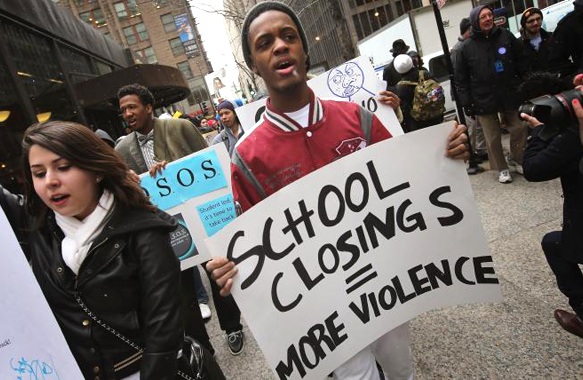By Julianne Hing | ColorLines. Schools & Youth. Tuesday, May 27 2014, 7:20 AM EST
Sixty years after Brown v. Board of Education, schools are still both separate and unequal. Community and civil rights groups say they’ve identified a key force that’s aggravated the inequity: school closures. On May 14, on the same week the nation recognized the 60th anniversary of the Supreme Court’s landmark school desegregation ruling, the civil rights group Advancement Project and the national community group network Journey for Justice Alliance filed three federal complaints with the U.S. Department of Education and Department of Justice alleging that school closures in Newark, Chicago and New Orleans discriminate against African-American students.
“We’re in a new era of separate and unequal,” says Jadine Johnson, a staff attorney at the Advancement Project. “Inequity and discrimination still occurs in many schools across the country.” In Chicago, Johnson says, black students make up 40 percent of the district enrollment but were 88 percent of those affected by the 111 school closures the city has undertaken since 2001. In Newark, African-American students comprise 52.8 percent of the district enrollment, and 73.4 percent of those whose schools were closed. In New Orleans, African-American students are 82 percent of the district’s schoolchildren, but 96.6 percent of those whose schools closed. “When you look at who’s impacted, you realize this is more than just reform. This is discrimination and this is abuse,” Johnson says.
'When you pull back the data, even using (school districts’) own metrics and standards, school closures' are selectively used against students of color.'
~ Jadine Johnson, a staff attorney at the Advancement Project
School closures are one of four turnaround options outlined by the federal government for transforming schools deemed failing based on their test scores. The other options include firing a school’s principal and staff and rehiring no more than half the school’s staff, and restarting a school and handing it over to a charter school. School closure is typically seen as a measure of last resort only for those school sites beyond repair. But it’s all too frequently used in communities of color, says Jitu Brown, director of the Journey for Justice Alliance.
What’s more, says Johnson, “When you pull back the data, even using
New Orleans, set to become the nation’s first charter-only school district this fall, has been ground zero for school closure-driven reforms. In the city’s post-Katrina reform frenzy, New Orleans has shut down all but five of its traditional public schools, kicked out tenured teachers, and replaced schools with charters and a predominantly black teaching force with young, overwhelmingly white recruits from the controversial education reform and teaching training program Teach for America. However, the complaint alleges, struggling charter schools with higher white enrollments have been spared as the district “turned a blind eye and allowed those schools to remain open.”
As neighborhood schools are shuttered, students in New Orleans have to cross town, sometimes up to 10 and 15 miles, to get to school. That means that even young elementary school students are waiting at bus stops at 5:30 and 6:30 in the morning, the complaint alleges.
In New Orleans, that means that it’s much harder for parents to be involved in their kids’ education, says Minh Nguyen, executive director of the community organizing and advocacy group VAYLA-New Orleans. Parents without cars can’t just pop over to their children’s school for a parent-teacher conference, or lean on the community for advice in navigating their child’s faraway school, says Nguyen.
“Schools are cornerstones of communities,” says Adrienne Dixson, a former New Orleans public school teacher and professor of education policy at University of Illinois. They’re very often the heart of the community, the only place where parents and families and community members regularly interact. And when they’re gone, it undercuts a community.
In Chicago, a rash of gun violence in recent years has been aggravated by school closures, says Brown, the director of the Journey for Justice Alliance. As a result of school closures, students have been forced to cross neighborhood and rival gang lines to get to school, putting themselves in daily harm just to get their education.
What’s more, the complaint says, when schools are shuttered, students are reassigned to schools that are very often no better than the ones they were sent away from.
School closures are not limited to the three cities named in the federal complaints. Baltimore, Columbus, Detroit, Houston, Milwaukee , Philadelphia, Pittsburgh and St. Louis have all closed dozens of schools in the last 15 years. New York City has closed 140 since 2002. “The common element among them is they’re district with high concentrations of kids of color, most of them in poverty,” says Dixson. Indeed, school closures are a phenomena which is disproportionately targeted at schools with high African-American and Latino enrollments.
There is a political tension, though. The Obama administration, via reform initiatives such as Race to the Top, has written school closures into its reform mandates. The Department of Education, in other words, is arguably driving the very civil rights violations that groups are asking it to investigate.
The Department of Justice did not respond to a request for comment. A Department of Education spokesperson told Colorlines that the agency doesn’t confirm the receipt of federal complaints, but does let relevant parties know if it opens an investigation from a complaint it’s received. Johnson of the Advancement Project and Brown of the Journey for Justice Alliance both said they had not heard anything from the Departments of Education or Justice.
“In America, we have good schools being destabilized as a direct result of district policy and the continuation of destructive policies, and being repackaged and sold to us as school reform,” says Brown. “We’re trying to call [Attorney General Eric] Holder to the plate and say, ‘You gotta swing.’”












Leave A Comment